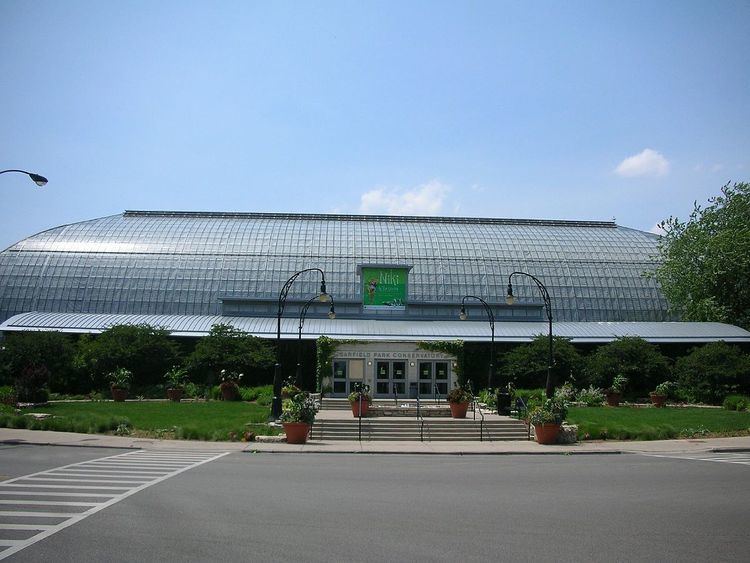Director Mary Eysenbach | ||
 | ||
Established 1880s, present structure 1908 Website Garfield Park Conservatory | ||
Garfield Park Conservatory, located in Garfield Park in Chicago is one of the largest greenhouse conservatories in the United States. Often referred to as "landscape art under glass," the Garfield Park Conservatory occupies approximately 4.5 acres (18,000 m2) inside and out and contains a number of permanent plant exhibits incorporating specimens from around the world (including some cycads that are over 200 years old)
Along with the Lincoln Park Conservatory on Chicago's north side, the Garfield Park Conservatory provides significant horticultural collections, educational programs and community outreach efforts.
Conservatory history
In the late 19th century, each of the three large West Side parks had its own small conservatory and propagation greenhouses. After 20 years of use, these conservatories had fallen into a state of disrepair and had become obsolete.
In 1905, Chicago's West Park Commission's general superintendent and chief landscape architect, Jens Jensen, demolished the three smaller greenhouses in Humboldt, Douglas and Garfield Parks to create what was intended as "the largest publicly owned conservatory under one roof in the world" in Garfield Park. Many of the original plantings came from the three smaller Westside conservatories.
Constructed between 1906 and 1907, the Garfield Park Conservatory was designed by Jensen in collaboration with Prairie School architects Schmidt, Garden and Martin and the New York engineering firm of Hitchings and Company. It represents a unique collaboration of architects, engineers, landscape architects, sculptors and artisans.
Jensen conceived the conservatory as a series of naturalistic landscapes under glass, a revolutionary idea at the time. The simple yet strong shape of the structure, which is meant to emulate the haystacks of the Midwest, complements the collection of plants and foliage that it houses.
Today, the conservatory still follows the original tenets of Jensen. One of the most popular rooms is the first presented to visitors, the Palm Room. In it over 7 dozen varieties of palm trees can be found from the over 2,700 known to exist today. Of particular importance is the double coconut palm first grown by employees of the conservatory in 1959. The double coconut palm is only found off the coast of South Africa in its native environment and produces what is believed to be the largest seed of any plant in the world weighing up to 50 lb (23 kg). The double coconut palm at the conservatory died of currently unknown causes in February 2012. Because of the species' rarity in the wild, and the challenges of cultivation, it is not expected to be replaced.
After many decades of neglect, the conservatory underwent a multimillion-dollar restoration in 1994. The non-profit Garfield Park Conservatory Alliance formed to help maintain the structure and provide programs and services for visitors.
In a hailstorm on the night of June 30, 2011, the conservatory suffered catastrophic damage to glass in showrooms as well as production houses where plants are grown or stored. Five recently renovated showrooms contained laminated glass and therefore sustained less damage. Some areas reopened to the public July 3. The Fern Room reopened December 1, 2011, and the remaining areas opened January 24, 2012. In 2012, the conservatory won the National Medal for Museum and Library Services.
